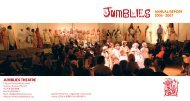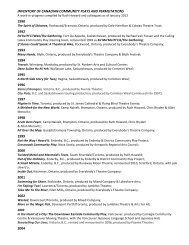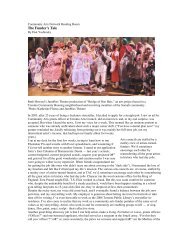publication - Jumblies Theatre
publication - Jumblies Theatre
publication - Jumblies Theatre
- No tags were found...
You also want an ePaper? Increase the reach of your titles
YUMPU automatically turns print PDFs into web optimized ePapers that Google loves.
The community artist in the Creative CityEngaged citizen or‘regeneration bulldozer’?by Maggie HutchisonAt a March 2008 conference of community artists called Art at the Hub, hosted by the Toronto ArtsCouncil Foundation, Joe Berridge of the planning firm Urban Strategies, addressed the crowd with animpassioned pitch for the ‘Creative City’. “The Creative City is…about innovation, about risk-taking,about leadership”, he argued, citing Paris and London as Creative Cities par excellence. 1 Berridgeencouraged conference attendees to revitalize our workplaces, our working practices and, ultimately, ourcities; transforming them into exemplary hubs of creativity. And he had specific ideas as to how we shoulddo it. In order to revitalize, Berridge suggested that we abolish meetings and other collective processes,and embrace the individuality and inductive thinking that he argued are essential to an artistic modality.“Beauty is not a collective product, it is an individual product…This runs completely counter to the waywe have structured all of our institutions, in which the power of the collective suppresses the power of theindividual”, Berridge insisted. 2Despite the fact that Berridge’s premise contradicted the working practices of the constituency he wasaddressing (community artists, whose art practices emphasize both process and final product, favouringcollaborative work as well as individual artistic vision) the comments that would cause many in theaudience to take real umbrage followed in the question and answer period. One audience memberasked about the fate of poor people in the “revitalized” communities lauded by Berridge. Anotherasked whether, in light of the displacement of low-income residents that tends to accompany urbanbeautification, the city has taken any measures to ensure affordable housing for artists in Toronto. In theface of such critical questions Berridge was defiant. “Cities aren’t static things. They’re endlessly, endlesslychanging and churning places, and this is good”, he said. “I see the arts community as actually beingsomething of a kind of regeneration bulldozer that pushes on the leading edge into new neighbourhoodsand fixes them up. And eventually they become Yorkville 3 …This is just part of life…This is great,this is how it ought to be… You are, whether you like it or not, kind of the front line troops of urbanregeneration.” 4Berridge’s remarks at Art at the Hub and, in fact, the theme of the conference as a whole (art’s role in therevitalization of neighbourhoods and the development of place-based communities) are indicative ofan important if not immediately evident moment for Toronto’s community artists. Through gatheringslike Art at the Hub and subsequent meetings with politicians and funders to discuss their role in the city’scultural renaissance, artists are being encouraged to build the ‘Creative City’. Despite the fact that manycommunity artists may still not be aware of what this amorphous term actually refers to, we are, in fact,vital to the success of such a project because, as the conference title made clear, in the Creative City art is“at the hub”. It is particularly important for community artists, who engage with their local surroundings(be they in the form of parks, people, streets or businesses) to understand what is meant by the ‘CreativeCity’ and ‘neighbourhood revitalization’. What often goes unmentioned in these discussions is thedisplacement that usually accompanies urban “regeneration”.Out Of Place, Issue 1, Spring 2010, <strong>Jumblies</strong> Press31








